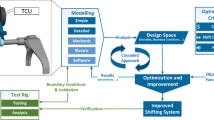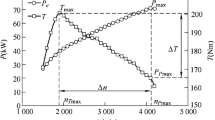Abstract
The main factors and limitations that need to be considered when designing electric drives (ED) that provide cosmonauts’ mobility in vertical and horizontal planes in the working space of simulators are determined when weightlessness and reduced gravity conditions of planets or satellites are simulated on the Earth. Analytical expressions are obtained for electric motor torques calculations taking into account factors and limitations imposed on ED functioning of simulators under consideration. The algorithm for rational choice of electric motors and mechanical transmission parameters for simulators with cosmonauts’ weight compensation is proposed. An example of electric motors and mechanical transmission parameters choice providing cosmonauts vertical and horizontal movements on the simulator is presented using the proposed algorithm.
Access this chapter
Tax calculation will be finalised at checkout
Purchases are for personal use only
Similar content being viewed by others
References
Ignatiev SV, Khripunov VP (2011) Tasks and principles for creating simulators for cosmonauts training for the Lunar and Martian programs. Manned Flights Space 2(2):94–98
Huan S, Wang S, Deng H (2016) Research on desktop system of the space flight training-simulator. Lect Notes Electr Eng 406:583–591. https://doi.org/10.1007/978-981-10-2323-1_65
Li J, Ye Q, Ding L, Liao Q (2017) Modeling and dynamic simulation of astronaut’s upper limb motions considering counter torques generated by the space suit. Comput Methods Biomechan Biomed Eng 20(9):929–940. https://doi.org/10.1080/10255842.2017.1310850
Piovano L, Brunello MM, Musso I, Rocci L, Basso V (2013) Virtual reality representation of martian soil for space exploration. Pattern Recogn Image Anal 23(1):111–129. https://doi.org/10.1134/S1054661812040141
Qiao B, Chen Z (2014) A passive exoskeleton robotic simulator for reduced-gravity locomotion training of astronaut. Yuhang Xuebao J Astronaut 35(4):474–480. https://doi.org/10.3873/j.issn.1000-1328.2014.04.015
Ma O, Lu Q, McAvoy J, Ruble K (2010) Concept study of a passive reduced-gravity simulator for training astronauts. In: Paper presented at the proceedings of the ASME design engineering technical conference, vol 2 (Parts A and B), pp 655–664. https://doi.org/10.1115/detc2010-29079
Xiu W, Ruble K, Ma O (2014) A reduced-gravity simulator for physically simulating human walking in microgravity or reduced-gravity environment. In: Paper presented at the proceedings—IEEE international conference on robotics and automation, pp 4837–4843. https://doi.org/10.1109/icra.2014.6907567
Wang BZ, Xiong Y (2013) Review of manned lunar training simulator. Xitong Fangzhen Xuebao J Syst Simul 25(8):1820–1828
Fujii HA, Uchiyama K, Yoneoka H, Maruyama T (1996) Ground-based simulation of space manipulators using test bed with suspension system. J Guid Control Dyn 19(5):985–991. https://doi.org/10.2514/3.21736
Pyatibratov GYa, Papirnyak VP, Polezhaev VG et al (1995) The state, problems and ways to improve weightlessness simulation systems for ground testing of space equipment. Tech Sci 3–4:39–49. Universities Messenger. North-Caucasus region
Debda DE, Pyatibratov GYa (2001) Capabilities analysis of active and combined electromechanical gravity compensation systems for objects to be weight relieved. Electromechanics 2:33–37. Universities Messenger
Pyatibratov GY, Bekin AB, Bogdanov DY (2015) Retrofit simulator to train cosmonauts for working in non-gravity and reduced gravity environment. Procedia Eng 129:42–50. https://doi.org/10.1016/j.proeng.2015.12.006
Pyatibratov GYa, Kravchenko OA, Papirnyak VP (2010) Methods of realizing and development trends for simulators for cosmonauts training to work tn weightlessness. Electromechanics 5:70–76. Universities Messenger
Sukhenko NA, Kravchenko OA, Pyatibratov GYa, Bekin A.B (2013) Principles of construction and implementation af gravity compensation systems. Universities Messenger. North-Caucasus Region. Technical Sciences 2:32–35
Kivo AM, Kravchenko OA (2010) Problems and prospects for creating simulators with partial cosmonauts’ dedilation for the Lunar and Martian programs. South-Russian. state. tech. un-t. Novocherkassk, p 18. DED. in VINITI on June 18, 380:132010
Kivo AM, Kravchenko OA (2012) Determination of the energy characteristics of electromechanical stands with partial de-weighting. Universities Messenger. Electromechanics 3:45–50 (In Russian)
Pyatibratov GYa (1993) Multicriteria choice of parameters of electromechanical systems of compensation of gravity forces during vertical displacements of objects. Universities Messenger. Electromechanics 5:65–70. (In Russian)
Author information
Authors and Affiliations
Corresponding author
Editor information
Editors and Affiliations
Rights and permissions
Copyright information
© 2021 The Author(s), under exclusive license to Springer Nature Switzerland AG
About this paper
Cite this paper
Kivo, A.M., Kravchenko, O.A., Bogdanov, D.V. (2021). The Algorithm’s Development for Finding of Rational Parameters of Electric Drives of Exercise Machines with Compensation of Astronauts’ Weight. In: Radionov, A.A., Gasiyarov, V.R. (eds) Proceedings of the 6th International Conference on Industrial Engineering (ICIE 2020). ICIE 2021. Lecture Notes in Mechanical Engineering. Springer, Cham. https://doi.org/10.1007/978-3-030-54814-8_58
Download citation
DOI: https://doi.org/10.1007/978-3-030-54814-8_58
Published:
Publisher Name: Springer, Cham
Print ISBN: 978-3-030-54813-1
Online ISBN: 978-3-030-54814-8
eBook Packages: EngineeringEngineering (R0)




